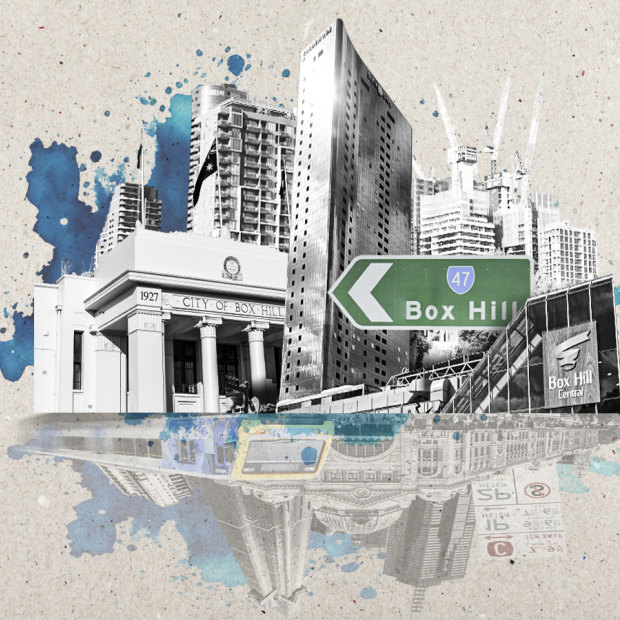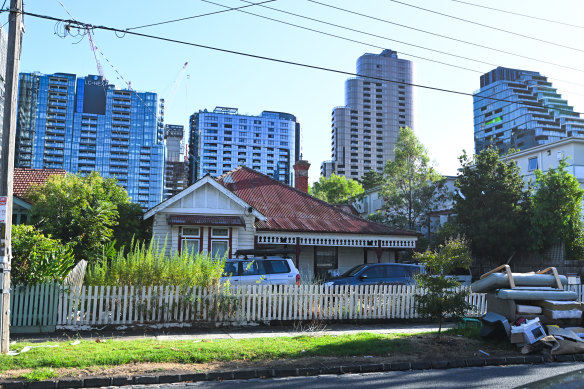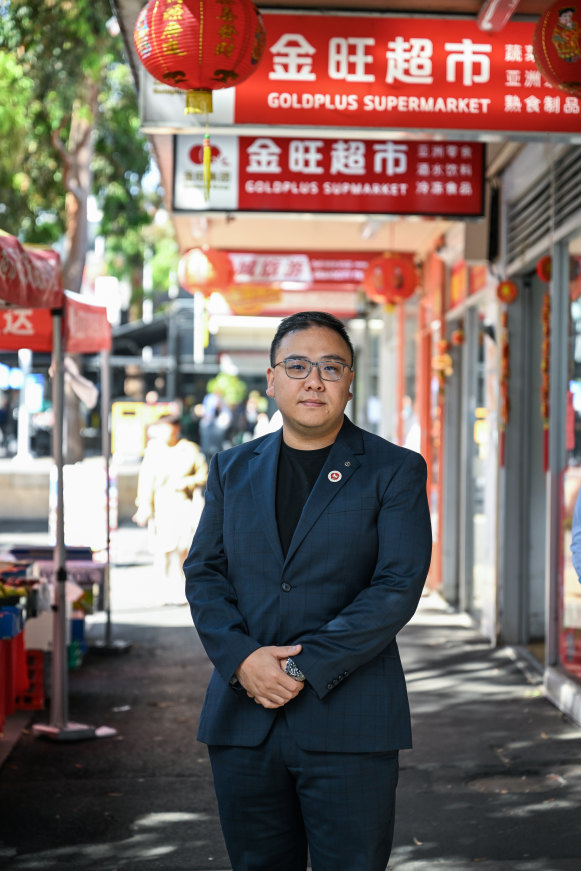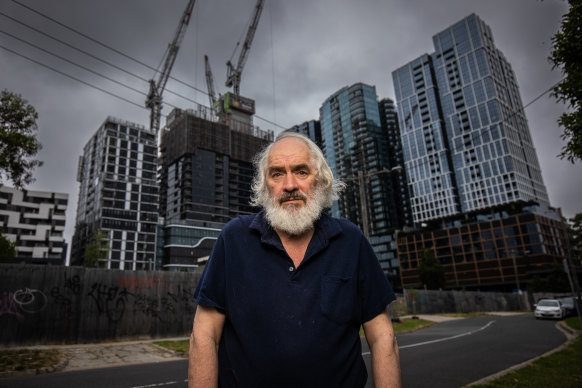This was published 2 years ago
Why this high-rise heart of suburbia could be Melbourne’s new CBD
A little over 14 kilometres from the city centre there’s a rapidly developing suburb that could have everything a CBD needs.

Box Hill’s skyline is taking on the shape of a mini-CBD.Credit: Jamie Brown
If one of the metrics of a capital city’s second CBD is its level of high-rise development, then Box Hill is ahead of the curve.
Twenty years ago, Box Hill looked very much like a typical Melbourne suburb.
But since the completion of the 20-storey Australian Taxation Office building on Whitehorse Road in 2015, its skyline has continued to rise, looming over any single-storey weatherboard still standing in its centre.

An old Box Hill weatherboard home is surrounded by high-rises.Credit: Joe Armao
Many of the 10 towers taller than 10 storeys are crowded around Whitehorse Road, including the tallest outside Melbourne’s CBD: the 36-storey Sky One apartment building. It will soon be dwarfed by a 51-storey building approved by Whitehorse Council last May – one of several major projects under way.
The transformation has cleaved a divide between newer and younger residents, and those who have lived there for half a century.
Melbourne’s CBD is congested, and new centres are needed, planning specialists say. In the Second CBD series, The Age is exploring three of metropolitan Melbourne’s best options for secondary CBDs – Clayton, Box Hill and Sunshine – decades after planners started plotting how to decentralise the city.
Selected in consultation with experts, these locations are middle suburbs accessible to populous outer and inner parts of Melbourne, and sites of major transport infrastructure projects. They show promising signs of development and have been previously identified for their growth potential.
Box Hill, in the middle of Melbourne’s east, has developed the feel of a fledgling city.
‘Bursting with potential’
Its centre buzzes with Chinese restaurants serving up crispy-skinned roast duck and rice noodles, while shoppers dash between retail stores and the Asian fresh food market.
The streetscape is modern and pedestrian-friendly, and public transport options abound between the train station, tram stops and bus interchange.
For Whitehorse mayor Mark Lane, it’s long been a no-brainer that Box Hill should play the role of a second city for Melbourne. Strengthening its prospects, he says, is that the suburb is home to Box Hill Hospital, Epworth hospital and TAFE course provider, the Box Hill Institute.
“[It’s] bursting with potential,” Lane says. “It was all really primed for a bigger development, for a bigger ‘CBD’, if you like.”
Lane believes Box Hill’s unique cultural make-up is what has drawn developers. Less than a third of the suburb’s residents were born in Australia (compared to two-thirds statewide) and almost half had Chinese ancestry at the 2021 census.
“We have a population that has come from overseas and are used to high-density living, so I think developers see that as an opportunity,” he says.
Asian Business Association of Whitehorse vice-president Richard Shi says Chinese migrants had been attracted to Box Hill because of its proximity to good schools, and as Chinese businesses continued to cluster in the area, the cultural and linguistic incentives grew.
This transformed Box Hill into a business hub for the Asian community, he says.
“The Chinese migrant population is the reason Box Hill is the flourishing city it is today. They brought in a huge influx of investment.

Richard Shi, vice president of the Asian Business Association of Whitehorse, says Box Hill needs more white-collar jobs and open space.Credit: Joe Armao
“[They also] come from big cities where it’s normal to have towers – they probably lived in a tower – and to come here to see individual houses is actually quite alien to them.”
Few white-collar jobs
Box Hill’s Lunar New Year festivities are renowned. This year, they were organised by Shi’s association. The prime minister and an estimated 120,000 people attended.
Shi says the suburb was hit hard by COVID-19 because it lost Chinese students, tourists and people who lived in both countries. This, he says, prompted his organisation to help Box Hill cater better for Asian and non-Asian communities.
But Box Hill is falling short in white-collar job prospects if it wants to be a secondary CBD. Most of the development in the suburb has been residential rather than commercial.
“You mainly have retail and low-income service industry jobs, but not many corporations and not much innovation,” Shi says.
Lane says the council will develop a plan for attracting more employers over the next 18 months, including lobbying for more government departments and new financial incentives to attract more private players.
“We’ve got the people, now we need the jobs,” he says. “If we can get residences and jobs somewhere parallel, Box Hill will be a successful city.”
Suburban Rail Loop challenge
To achieve that, Shi also thinks Box Hill needs more structured open space that can be used for recreation and events – like its own version of Federation Square.
“Box Hill went into a crazy development stage and with real estate so expensive, nobody ever thought to build these things here,” he says.
Box Hill will be getting one of the first Suburban Rail Loop stations and early works have begun, with the eastern section expected to open by 2035.
While Lane hopes it may lead to more people commuting to Box Hill for work, he is wary of the effects of the drawn-out construction, as he says it will rip up a lot of land, including about half of the Box Hill Gardens – a problem when the suburb is starved of enough open space.
“I’ll be frank, I struggle to see the real benefits [of the Suburban Rail Loop] for our residents right now,” he says.
“We have high-rise living; people need a park to go out to. To lose half of that space for a long period of time is going to hurt the residents.”
The state government will have planning powers over about a 1.6-kilometre radius around each Suburban Rail Loop station, which Lane says is “concerning” and the council is pushing for more detail on the implications.
“It’s going to be a challenge,” he says. “For us, it’s ‘hang on a minute. We’ve actually done a pretty damn good job’. We believe our strategy is working for Box Hill; it’s growing, it’s becoming more vibrant.
“There’s a risk that Box Hill could become a disjointed collection of major transport and development projects. Integration between these projects will make or break Box Hill.”
Deputy Premier and Suburban Rail Loop Minister Jacinta Allan says station precinct planning will begin in coming months with community consultation.
“We don’t want to presume the outcome of what goes on in each of those places before we’ve had the opportunity to work with councils and communities,” Allan says.
Whitehorse Residents and Ratepayers Association president Tanya Tescher says many long-term Box Hill residents are already unhappy with the accelerating development. “All you see is towers, not the sky,” she says.
Tescher, who is also a former councillor, believes that the idea of secondary cities is “ridiculous” in a work-from-home era. “The CBD can’t fill its offices... Why would you want more towers built in Box Hill that will be empty as well?”
The perils of progress
Kevin Earl, 68, lives just off Whitehorse Road and recalls being able to kick the footy up and down his street in his youth. That’s now impossible, he says.
“It’s totally changed; it’s not safe to cross our street any more because we’ve inherited high-rise towers and car parking for 100 cars at one end of the street with more approved,” Earl says.

Long-term Box Hill resident Kevin Earl is concerned about overdevelopment.Credit: Scott McNaughton
As far as Box Hill becoming a second city, Earl says “the horse has bolted”.
He used to argue against low-density ’80s units. Now, he’s fighting skyscrapers. And the roads can’t handle the increasing traffic, he says.
But Whitehorse mayor Lane reasons that concentrating development in Box Hill – where it is occurring “organically anyway” – means that surrounding suburbia can be preserved.
“It’s tough and I know there are a lot of residents who live in this area who have been there forever and don’t like the change. But a lot of younger people live in the high-rises,” he says. “At some point things have got to progress.”
NEXT: A promising second CBD option in the west
The Morning Edition newsletter is our guide to the day’s most important and interesting stories, analysis and insights. Sign up here.